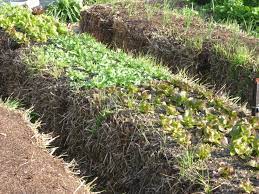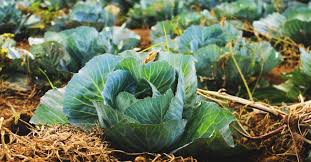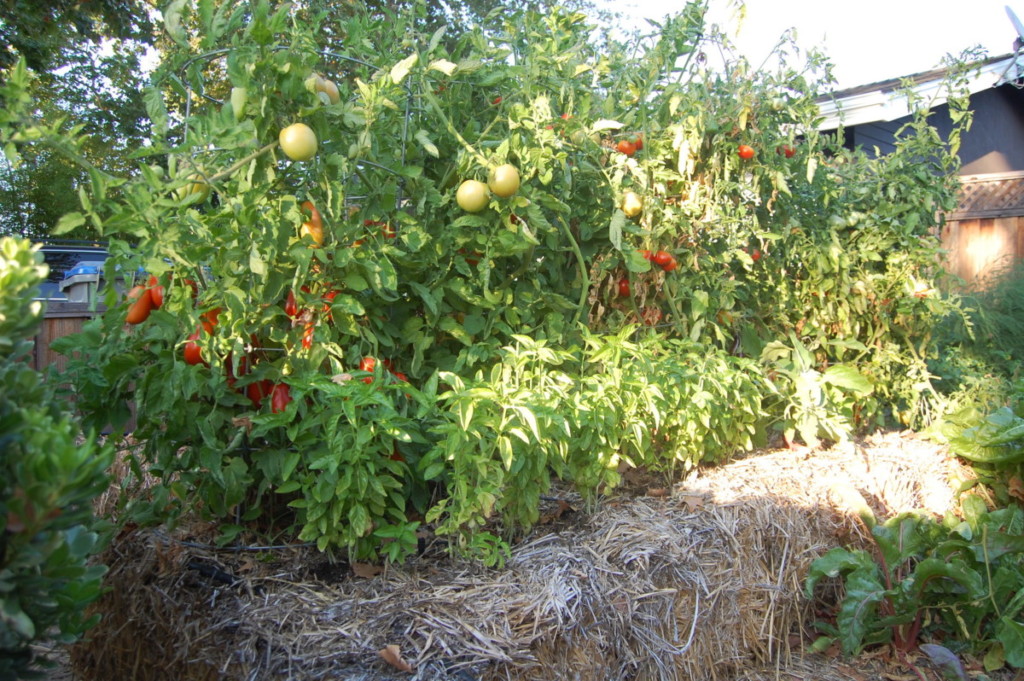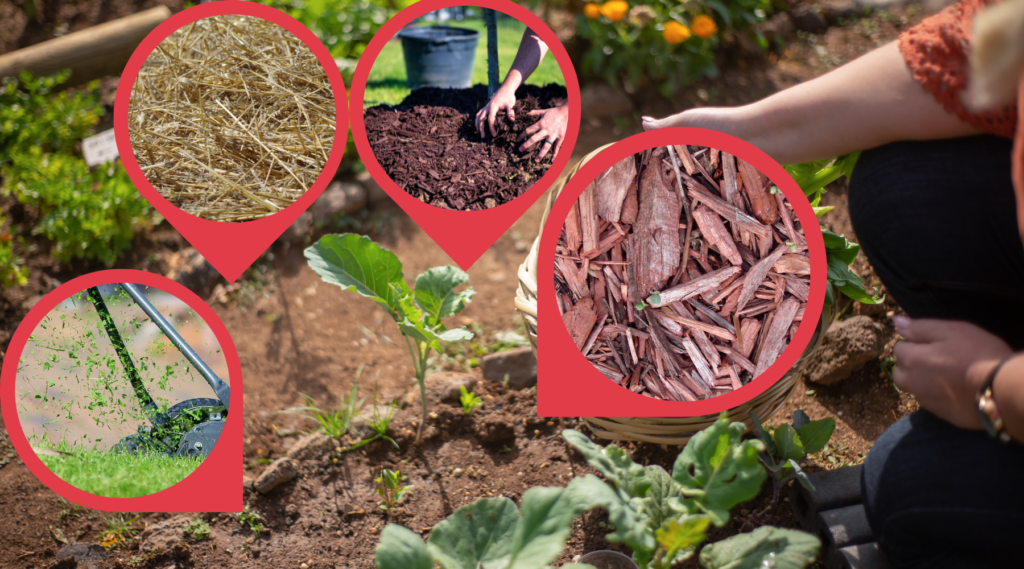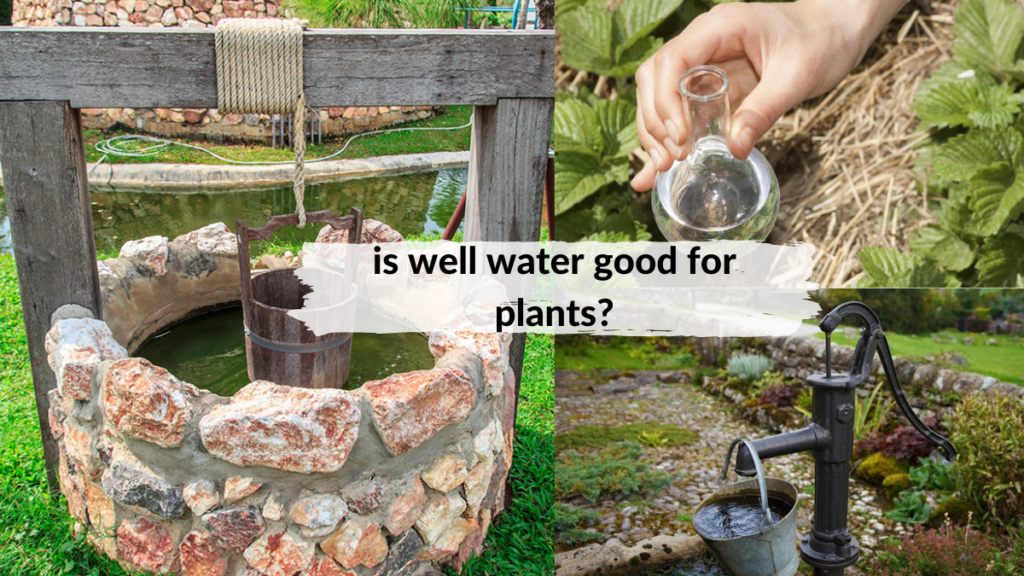Some people live in areas with soil that consists of sand or heavy clay. This type of soil can be amended but creating loamy soil will take a lot of work. Raised garden beds can be an option. For example, you can build a raised bed vegetable garden by piling up stones or boards into a box form and then filling it with soil. However, raised beds can be costly to make and maintain.
Aside from buying the materials for building the bed, you also need to get high-quality compost and bagged soil to fill your garden if the soil is poor. But you do not need to worry because you can still grow plants in your backyard through straw bale gardening.
One of the best things about this self-contained garden is that it is inexpensive to build and ideal for areas with limited space. Since straw bales raise gardens off the ground, they are perfect for people with limited mobility.
Apart from making gardens more accessible, straw bale gardening allows you to recycle rich organic material into a beautiful landscape on your organic farm or relocate the garden if necessary. If you want to try gardening in straw bales, here are some tips to help you get started.
what do you need to build a straw bale garden?
You can find bales at garden centers and local farm supply or hardware stores. Hay contains weed seeds and grass, so it is best to use straw bales. Go for organic straw as it does not have herbicides that may stay and kill your plants.
Dry bales usually cost around $10 – $15. It is also a good idea to buy several metal stakes that you can drive into the ground for added stability. You should start this process several weeks before planting anything as it takes some prep work and time.
where to build a straw bale garden
Choose an area that receives six to eight hours of sun daily if you want to grow vegetables. Place some cardboard or landscape fabric before putting your straw bales to control weeds. Bales will kill the grass underneath them, so you should take this factor into account. Also, it would be impossible to move wet, heavy straw bales after you begin watering them.
how to condition straw bales
Here are some tips on how to condition your straw bales.
days 1 to 3
You need to keep the bales moist, so water them once or twice daily. Continue adding water until it seeps through the bottom of the bale. Watering the bale increases its weight, so make sure it is in the right location in your garden. The bale’s interior will start to warm as the composting process (decomposition inside the bale) starts.
day 4
On the 4th day, scatter dolomitic lime (two cups) on top of the bales and add either ammonium sulfate (one cup) or urea (1/2 cup). Use your desired fertilizer for the rest of the conditioning period. Moisture must be retained evenly throughout the straw bale, but you do not have to wet all bales until water seeps through the bottom like in the first three days. If you are doing organic gardening or container gardening, you can use blood meal instead of ammonium sulfate or urea to provide nitrogen.
days 5 to 6
If you are using ammonium sulfate, you must sprinkle ammonium sulfate (one cup) on top of each bale from the fifth day onwards. Water the bale thoroughly after applying fertilizer to speed up decomposition. You do not have to add lime.
If you prefer urea, sprinkle each bale with a half cup of urea from the fifth day onwards. There is no need to add lime, but you should water all bales after applying fertilizer to expedite the decomposition process.
days 7 to 9
You can reduce the amount of ammonium sulfate and fertilizer by half. Water the bale thoroughly after applying fertilizer, but do not overwater. Excessive watering can result in loss and leaching of nutrients from the bale.
The same tips apply to urea. Make sure to reduce the amount of urea and fertilizer by half. Sprinkle ¼ cup of high-quality urea on top of each bale then apply your chosen fertilizer. The bales require water regularly but do not overwater them.
day 10
You need to add a complete fertilizer on the 10th day. Evenly sprinkle the bales with 10-10-10 fertilizer (one cup) or 8-8-8 (one and a half cups) then water them thoroughly. You need to do this whether you are using ammonium sulfate or urea.
Conditioning the bales takes around two to three weeks. You can start planting once the straw bales are conditioned. The bales should have cooled down to 99°Fahrenheit or below. You can measure the temperature using a compost thermometer or touch the top of the bale with your hand.
Excessive heat can affect seeds or transplants. If the bales are too warm, continue watering them every day to retain moisture as required until their internal temperature lowers. Once they have cooled, you can start planting.
straw bale gardening methods
Here are two straw bale gardening methods that you can try at home.
flatbed planting
Flatbed planting is ideal for those who want to plant seeds like pole beans. Put a growing medium (two to four inches) across the top of your conditioned bales to create a flatbed then moisten it with water. Place the seeds at the suggested planting depth for bale gardening.
using divots or pockets
You can plant seedlings in holes, also known as divots or pockets, within your straw bales. This straw bale method is ideal for transplants like tomato and pepper plants, but you can also use it to plant seeds. However, if you are planting seeds, you should follow the recommended planting depth on the seed packet. The depth depends on the crop you planted, the suggested depth for seeds, or the depth you have previously grown it (if you are planting seedlings).
You can use a garden trowel or handheld pruning to excavate the hole by hand. Holes are made based on the number of plants per bale. After digging a hole, place the seed or transplant then add a growing medium to fill the remaining space. You can dig six by six-inch holes, but there is usually a recommended depth for most crops that must be followed.
growing medium
Adding a growing medium provides plants with a good rooting matrix for production and establishment. You can use different growing mediums. For instance, you can use commercial potting soil alone or mix it with aged manure. You only need to follow the 1:1 mix ratio.
If you do not want to use potting soil, another option is to buy compost from local stores near you. Home-cured compost is also a good option if it is properly decomposed and does not have any weed seeds.
You can grow tall plants, smaller plants, or root crops like onions, sweet potatoes, and carrots, but it would be challenging. Okra and corn are not suitable for straw bale gardening as they grow tall, become top-heavy, and have shallow plant roots and pollination restrictions. Tomatoes may need staking for added support. Beans and determinate or bush tomatoes may grow better than vining or indeterminate tomatoes, but trellis can give space for the latter.
If you want to build a trellis, place posts (five to seven-foot-tall) at both ends of the entire bale. You can drape opaque or transparent plastic tarps over the top string or wire to build a cold frame for added protection during the early season. The tarps should be tied off properly so that they do not touch the plants. Contact may result in cold damage.
how to maintain straw bales
After planting seeds or transplants, maintain your bale garden like you would with raised beds or in-ground gardens. However, there are some exceptions. Here is what you need to know when it comes to straw bale maintenance.
disease control
One of the best things about straw bale gardening is that it helps protect the plants against soil-borne diseases like wilts. You can also buy transplants that are disease resistant for added protection against diseases. Straw bales often require watering to retain moisture, but you should not overwater them to the point that they are excessively moist because different diseases thrive in this kind of environment.
fertilization maintenance
Plants need additional fertilization as they start to grow. Nutrient leaching may occur in your straw bale garden and cause plant nutrient deficiencies. You can use complete fertilizers like 10-10-10 or 8-8-8 to maintain plant health. Apply a half cup to one cup of fertilizer to each bale monthly and water in properly. You can also use liquid fertilizers in a recycled passive watering bottle system.
If you want an organic fertilizer, you can use fishmeal, bone meal, compost, or blood meal. You can also use manure that produces nutrients at a slower rate than inorganic fertilizers.
irrigation maintenance
Monitor bales every day for moisture. Keep the zone around the plants moist. You may need to water the bales daily to prevent this area from drying out.
But how often should you water the bales? It will depend on temperature and drainage. You can place a recycled passive water bottle or timed soaker hose to save labor and time. The internal moisture of the bales must be retained, but you can let the outer edges dry out a bit.
weed control
Few weeds should grow as long as your compost and bales are weed-free. You must monitor the bales for any emerging weed and get rid of it immediately. If you placed the bales on a weedy area or existing turf, you need to put a barrier like cardboard or newspaper underneath the bales before conditioning.
insect control
Nematodes and ground-dwelling insects usually infest vegetable gardens during the growing season. Since straw bale gardens lift vegetable crops off the ground, it prevents cutworms and other insects from accessing them. Most straw bale gardens are usually recycled after one season, giving enough time to stop the lifecycle of many garden pests and reduce various problems in the future.
advantages and disadvantages of straw bale gardening
Straw bale gardens can have up to two growing seasons. You can recycle spent bales into a compost pile. Straw bale gardening usually needs little to no pesticides, so you can safely recycle bales. Straw bale gardening is ideal for local farmers or those who want to try raised gardens at home. Vegetable crops require at least eight hours of sunlight daily and since bales can be exposed to direct sunlight, it will not be a problem.
However, you should avoid placing the bale near your home as it can attract rodents. If you are going away for a trip, be sure to ask someone to water your straw bales to retain their moisture during the growing season. Rehydrating a bale that has dried out can be challenging, so you should prevent it in the first place.
Moreover, you should be aware of adjacent runoff from areas that have been treated with pesticides as the bales and vegetable plants may absorb these chemicals. For example, herbicides like those used in lawns could harm plants.
You do not have to worry if mushrooms start growing in your bale. As long as they are not in excess, it is okay to let them grow. You can plant annual herbs and flowers on the outer edges of the bales for added enjoyment and attraction.
hay bales vs. straw bales
What is the difference between a hay bale and a straw bale? The latter is a rectangular cube made of tightly packed dried stalks or stems of grains like barley, wheat, and oats. Straw bales are usually yellow-hold and can hold up well during the growing season. These bales also offer great insulation. Joel Karsten recommends drip irrigation for straw bale gardening.
On the other hand, hay bales are rectangular cubes made of forage crops like alfalfa and clover. They are usually greenish and may contain stray seeds and seed heads. Moreover, they are not as strong as straw bales. So, you should use straw bales, not hay. If you are planning a small seed, you can put a thin layer of weed-free soli over your bales.
If you want to try hay bale gardening, you have to pre-condition the bales for 12 days before you plant anything. Do this at least two weeks before the last frost day in your area. Conditioning speeds up the composting process within the hay bale and creates growing material for nourishing plants. You can use a gardening fork or spade to dig holes on top of the bales so that you can access the inside and start hay bale gardening.


